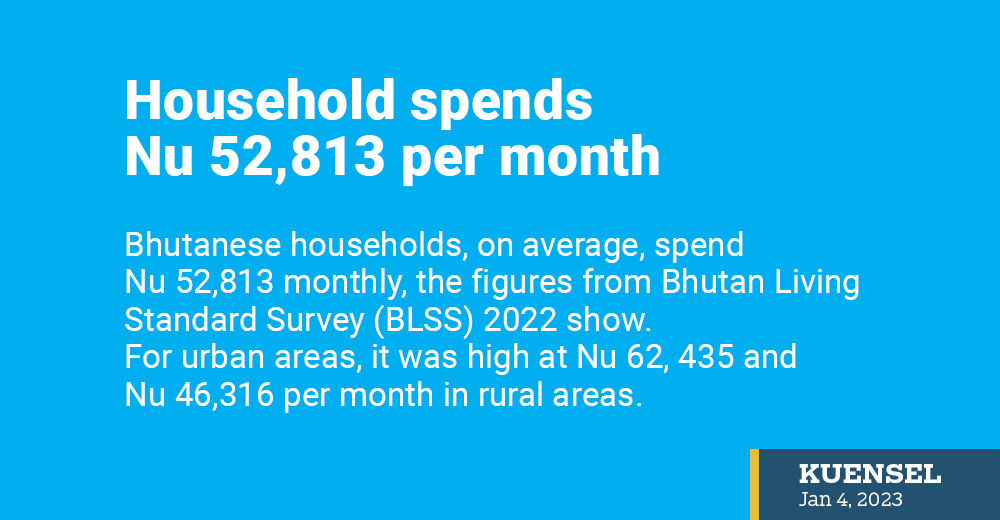… Non-food contributes more than 50 percent
Thukten Zangpo
Bhutanese households, on average, spend Nu 52,813 monthly, the figures from Bhutan Living Standard Survey (BLSS) 2022 show.
For urban areas, it was high at Nu 62, 435 and Nu 46,316 per month in rural areas.
Total household consumption expenditure is the sum of food and non-food consumption expenditure, excluding taxes, pension contributions and insurance premiums, and interest payments on loans by households.
Similarly, mean per capita household expenditure or an individual family member spent Nu 15,745 per month in the country. In urban areas, it was Nu 19,374 monthly and Nu 13,294 in rural areas.
For Bhutan, the average household size in the country was 4, 3.8 in the urban areas and 4.1 in rural areas. The number of households in the country was estimated at 164,331. Of these, 33 percent are in urban areas and 67 percent are in rural areas.

The mean household consumption expenditure among the richest 20 percent (Nu 85,430) was three times more than the poorest 20 percent (Nu 26,495), the report stated.
Compared to rural areas, the mean household expenditure was higher by 45.7 percent in urban areas.
For food, a household spends 43.4 percent of the expenditure equivalent to Nu 22,933 monthly on food expenses. For urban areas, it is Nu 24,938 and Nu 21,579 for rural areas. This, according to the National Statistics Bureau is 55.8 percent increase in nominal terms over Nu 14,718 in BLSS 2017.
The mean monthly per capita food consumption expenditure for urban areas was estimated at Nu 7,862 and Nu 6,253 per month for rural areas.
In urban areas, food takes about 40.7 percent of household expenditure. The poorest 20 percent spend 49.2 percent on food.
The share of food in the consumption expenditure of the richest 20 percent of urban households is 37.5 percent.
The households spend 15.3 percent of their food budget on dairy products, 14.3 percent on vegetables, 11.1 percent on other cereals and pulses, and 10.4 percent on meats. Around 10 percent of food expenditure was spent on spices and seasonings.
Non-food
For non-food, the household spent Nu 29,880 on average per month. This according to NSB is 58.8 percent higher in nominal terms compared to Nu 18,824 in BLSS 2017. Household level expenditure was higher in the urban areas (Nu 37,496 a month) than in the rural areas (Nu 24,736).
The mean monthly per capita non-food consumption expenditure in the country was estimated at Nu 8,843.
Similarly, in urban areas, per capita non-food consumption expenditure (Nu 11,512 per month per person) is higher than in rural areas (Nu 7,040).
The major non-food expenditure items are transport and communications (24.2 percent), miscellaneous expenditure (18.3 percent), rent (16.9 percent), clothing and footwear (10.1 percent), and the least is on health (4.5 percent).
The mean monthly consumption expenditure is highest in Thimphu (Nu 73,111), while Pemagatshel dzongkhag (Nu 34,585) has the lowest.
The monthly per capita consumption expenditure is highest in Thimphu (Nu 20,852) and the lowest was in Samtse (Nu 10,944) and Tsirang (Nu. 10,990). “The per capita consumption in Thimphu is almost two times higher than that of Samtse,” the report stated.
Income
In terms of income, the mean per capita annual household income was Nu 115,787. This comes to about 9,648 per month, lower than the household expenditure.
For urban households, it was Nu 168,064 that is more than two times the rural mean per capita income of Nu 80,578.
The report also stated that the mean annual household income was Nu 406,134. For urban households, the mean annual household income is Nu 598,759 that was 2.2 times more than that of the rural households (Nu 276,398).
The major sources of household income were wages or salaries (37.5 percent), followed by the sale of cereal, fruits and vegetables (23.9 percent), and meat, dairy products and eggs (11 percent).
The difference in the consumption expenditure and income could be because of the underreporting of income, non-reporting of wages and salaries, significant transactions in agricultural products in the informal market and income from forest products, the report stated.
On the other hand, the consumption of home-produced food and food received as gifts, may not have been reflected in income.


